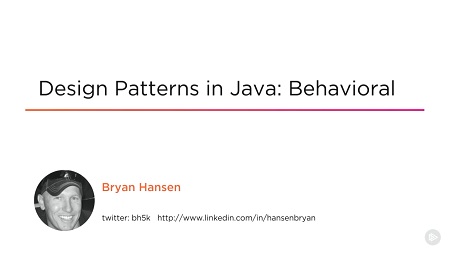
English | MP4 | AVC 1280×720 | AAC 44KHz 2ch | 4h 01m | 660 MB
The Gang of Four Design Patterns explained and implemented using Java.
This course is part of a 3 part series covering design patterns using Java. This part covers the behavioral design patterns, Chain of Responsibility, Command, Interpreter, Iterator, Mediator, Memento, Observer, State, Strategy, Template, and Visitor as defined by the Gang of Four. We look at examples in the Java API and code examples of each pattern.
Table of Contents
Course Overview
1 Course Overview
Behavioral Design Patterns Introduction
2 Introduction
3 Why Learn Patterns
4 Pattern Classifications
5 Which Patterns
6 How Do We Learn Them
7 Prerequisites
8 Next
Chain of Responsibility Pattern
9 Introduction
10 Concepts
11 Design Considerations
12 UML Diagram
13 Example Logging
14 Demo Logging
15 Exercise – Chain of Responsibility
16 Demo Approver
17 Pitfalls
18 Contrast to Other Patterns
19 Summary
Command Pattern
20 Introduction
21 Concepts
22 Design Considerations
23 UML Diagram
24 Example Runnable
25 Demo Runnable
26 Exercise – Command
27 Demo Switch
28 Demo State
29 Demo Macro
30 Pitfalls
31 Contrast to Other Patterns
32 Summary
Interpreter Pattern
33 Introduction
34 Concepts
35 Design Considerations
36 UML Diagram
37 Example Pattern
38 Demo Pattern
39 Exercise – Interpreter
40 Demo Interpreter
41 Pitfalls
42 Contrast to Other Patterns
43 Summary
Iterator Pattern
44 Introduction
45 Concepts
46 Design Considerations
47 UML Diagram
48 Example List
49 Demo List
50 Exercise – Iterator
51 Demo Iterator
52 Pitfalls
53 Contrast to Other Patterns
54 Summary
Mediator Pattern
55 Introduction
56 Concepts
57 Design Considerations
58 UML Diagram
59 Example Timer
60 Demo Timer
61 Exercise – Mediator
62 Demo Mediator
63 Pitfalls
64 Contrast to Other Patterns
65 Summary
Memento Pattern
66 Introduction
67 Concepts
68 Design Considerations
69 UML Diagram
70 Example Serializable
71 Demo Serializable
72 Exercise – Memento
73 Demo Memento
74 Pitfalls
75 Contrast to Other Patterns
76 Summary
Observer Pattern
77 Introduction
78 Concepts
79 Design Considerations
80 UML Diagram
81 Example Util
82 Demo Util
83 Exercise – Observer
84 Demo Observer
85 Pitfalls
86 Contrast to Other Patterns
87 Summary
State Pattern
88 Introduction
89 Concepts
90 Design Considerations
91 UML Diagram
92 Example ifelse
93 Demo ifelse
94 Exercise – State
95 Demo State
96 Pitfalls
97 Contrast to Other Patterns
98 Summary
Strategy Pattern
99 Introduction
100 Concepts
101 Design Considerations
102 UML Diagram
103 Example Comparator
104 Demo Comparator
105 Exercise – Strategy
106 Demo Strategy
107 Pitfalls
108 Contrast to Other Patterns
109 Summary
Template Method Pattern
110 Introduction
111 Concepts
112 Design Considerations
113 UML Diagram
114 Example Collectionssort
115 Demo Comparable
116 Exercise – Template Method
117 Demo Template Method
118 Pitfalls
119 Contrast to Other Patterns
120 Summary
Visitor Pattern
121 Introduction
122 Concepts
123 Design Considerations
124 UML Diagram
125 Example API
126 Demo Visitor
127 Demo Without Visitor
128 Demo Shipping Visitor
129 Demo Display Visitor
130 Pitfalls
131 Contrast to Other Patterns
132 Summary
What Next
133 What Next
Resolve the captcha to access the links!